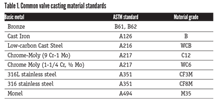Define Success: The First Step to Becoming an MVP
At a recent valve industry event, Mark C.
During his presentations and in his book, Thompson stresses that, before you can achieve success in your professional or personal life and become better valued by what he calls your MVPs (most valuable people), you must get clear about your definition of success. It is only by doing this that you can create a roadmap to accomplish it, and then recruit others to help you get there. He agreed to share many of the tools and techniques from his recent book with readers of VALVEMagazine.com.
You Don’t Have to Be “Right” to Be Effective
Your definition of success may not match that of the people with whom you interact. Too often we move forward assuming we know what success looks like for our MVPs when in fact we are projecting our values onto others, blocking our ability to actually hear the other person. We frequently spend our time talking more than we listen, then wonder why people don’t agree with us.
Winning Over Your MVPs
Thompson’s group partnered with The Wharton School to conduct a world success survey of high achievers. That survey showed that successful people define success in at least three distinctly different ways, and that by defining it for yourself and others early and often, you can greatly improve your odds and make your success more sustainable. Before embarking on any new goal or mission, Thompson recommends using these three definitions of success to check in with yourself and your MVPs on what matters most.
Thompson’s Three P's
- Purpose: What impact do you really want to have? How do you want to make a difference?
- Passions: What personal interests or talents could you apply to this project? You will have more fun, be more engaged and resilient to setbacks if this is personal.
- Performance: How will you measure short-term success today and for every step along the timeline of your project? How can you help your MVPs feel accomplished? How is performance being measured?
While Thompson acknowledges you may achieve short-term success by applying a lot of effort to any one of these three definitions, he says that professionals who sustained their success for 20 years or more always focused on finding the intersection of all three of these definitions for themselves and the people who matter to them.
By answering the following seven questions for each of your top objectives, Thompson says you will have a comprehensive understanding of your definition of success, which makes it easier to measure and achieve.
- What is the purpose of this priority or objective? How will it make your boss, your team and your customers more successful in achieving their objectives?
- How will you measure success personally? What end result do you want?
- Who else is defining success for this priority?
- How will others evaluate whether you’ve achieved success?
- What are the different measurements for success (Purpose, Passion and Performance)?
- What impact will success have on each stakeholder group?
- What’s in the way of success?
One of the most insidious things that can get in the way of success is simple distraction. Overcoming the many distractions that threaten us every day is a major accomplishment, but can easily be achieved with a little planning.
The Myth of Multitasking
According to Thompson, the number one complaint of the world’s most successful people interviewed by his team is that they feel overwhelmed by the blizzard of conflicting priorities at home and at the office. He referred to the ’80s classic Seven Habits of Highly Effective People by Steve Covey, who cautioned against compiling massive to-do lists without first taking a serious reality check: “Cut your priorities down to a few good things that matter most,” he insisted. “You can have it all, but not all at once!”
There is also solid research that says multitasking effectively destroys the likelihood of accomplishing anything truly meaningful. Professor Cliff Nass tested students at Stanford, where many of the greatest technology breakthroughs have been conceived. But even there he found multitasking severely limited participants’ memory, accuracy and productivity in performing tasks compared with students who did one thing at a time. In fact, their concentration was damaged by multitasking. They lost their ability to focus on any one relevant issue and didn’t perform nearly as well as people who kept their eye on one meaningful outcome at a time. With these things in mind, Thompson offered 10 key steps to help manage what may seem like an overwhelming amount of work.
Ten Steps to Focus
- Choose three top objectives for the next 24 hours and try to meet them.
- Do what matters most, first. What are the essential activities that will further your meaningful goals? Whittle down your to-do list to include only the things you care most about. Then do these things before you open your inbox or begin other day-to-day matters.
- Make some temporary sacrifices. Naturally, you care about more than just one thing. Simplify as best you can, but don’t add to the list without taking something else off. Remember, you can have it all, just not all at once.
- Don’t get it all done. Thompson relates the advice of an extremely busy physician/wife/mother/world traveler who says, “I have to select the actions that are going to give me the most return today. I focus on what matters to me and I accomplish that.”
- It’s okay to fire a friend. Remember that you pick your friends and you can fire the ones who drain your energy without giving anything back. Surround yourself with friends who help you find joy, meaning and growth—those who help you be who you are and who you want to be.
- Streamline daily and weekly activities. Tasks that take 10 minutes a day every day add up to a little over a workweek every year. If you can streamline these routine tasks, you can gain a lot of time for doing tasks that really matter to you.
- Delegate. Find a person who loves a task you dislike, and search for ways to automate, eliminate or double up on several tasks.
- Sharpen your skills. Thompson’s national survey showed that what Americans most admire in leaders, companies and each other is competence. He referred to the advice from his coauthor and mentor Brian Tracy who advises people, “Consider what one new skill could change your life the most. Become more proficient at that. Set aside time to learn a new skill.
- Reduce interruptions. Every time you stop a task and come back to it later you lose 5 to 15 minutes. It takes us a while to figure out what we were doing. This is also the number one reason we make mistakes. Find blocks of time when you can execute tasks start to finish and establish ways to minimize interruptions while you work.
- Have a place to stash stuff that doesn’t matter. Have a place to stash those things you’re not currently using so you can get to them if and when you need them, yet they will not distract you from your top priorities.
Mark C. Thompson is CEO and cofounder of Virgin Unite Mentors, Sir Richard Branson's network for executive coaching and entrepreneurial innovation. Learn more about his work and pointers for success at www.MarkC.Thompson.com. Kate Kunkel is senior editor of VALVE Magazine. Reach her at kkunkel@vma.org.
RELATED CONTENT
-
Actuator Issues? Use This Checklist!
While there may be 40 reasons valve actuators may stop working, there really is only a handful of components that can cause the problems. So, if you have an actuator on the fritz, here are the five things you need to check.
-
Solenoid Valves: Direct Acting vs. Pilot-Operated
While presenting in a recent VMA Valve Basics 101 Course in Houston, I found myself in a familiar role: explaining solenoid valves (SOVs) to attendees. (I work with solenoids so much that one VMA member at that conference joked that I needed to be wearing an I Heart Solenoids t-shirt). During the hands-on “petting zoo” portion of the program, which involves smaller groups of attendees, one of the most frequently asked questions I get from people came up: What’s the difference between direct-acting and pilot-operated SOVs, and how do we make a choice?
-
Air Valves in Piping Systems
Liquid piping systems are prone to collecting air from incoming fluids, pumps and connections.









 Unloading large gate valve.jpg;maxWidth=214)


